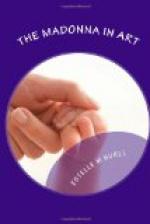As Raphael’s first inspiration for the pastoral Madonna came from the influence of Leonardo da Vinci, it is of interest to compare his work with that of the great Lombard himself. Critics tell us that the Madonna pictures in which he came nearest to his model are the Madonna in the Meadow and the Holy Family of the Lamb. (Madrid.) These we may place beside the Madonna of the Rocks, which is the only entirely authentic Da Vinci Madonna which we have.
It is only the skilled connoisseur who, in travelling from Paris to Vienna, and from Vienna to Madrid, can hold in memory the qualities of technique which link together the three pictures; but for general characteristics of composition, the black and white reproductions may suffice. Leonardo availed himself of his intimate knowledge of Nature to choose from her storehouse something which is unique rather than typical. The rock grotto doubtless has a real counterpart, but we must go far to find it. In the river, gleaming beyond, we see the painter’s characteristic treatment of water, which Raphael was glad to adopt. The triangular arrangement of the figures, the relation of the Virgin to the children, the simple, childish beauty of the latter, and their attitude towards each other—all these points suggest the source of Raphael’s similar conceptions. The Virgin’s hair falls over her shoulders entirely unbound, in gentle, waving ripples.
[Illustration: LEONARDO DA VINCI.—MADONNA OF THE ROCKS.]
We do not need to be told, though the historian has taken pains to record it, that a feature of personal beauty by which Leonardo was always greatly pleased was “curled and waving hair.” We see it in the first touch of his hand when, as a boy in the workshop of Verrochio, he painted the wavy-haired angel in his Master’s Baptism; and here, again, in the Virgin, we find it the crowning element of her mysterious loveliness. We try in vain to penetrate the secret of her smile,—it is as evasive as it is enchanting. And herein lies the distinguishing difference between Leonardo and Raphael. The former is always mysterious and subtle; the latter is always frank and ingenuous. While both are true interpreters of nature, Leonardo reveals the rare and inexplicable, Raphael chooses the typical and familiar. Both are possessed of a strong sense of the harmony of nature with human life. The smile of the Virgin of the Rocks is a part of the mystery of her shadowy environment;[2] the serenity of the Madonna in the Meadow belongs to the atmosphere of the open fields.
[Footnote 2: That the Leonardesque smile requires a Leonardesque setting is seen, I think, in the pictures by Da Vinci’s imitators. The Madonna by Sodoma, recently added to the Brera Gallery at Milan, is an example in point. Here the inevitable smile of mystery seems meaningless in the sunny, open landscape.]




